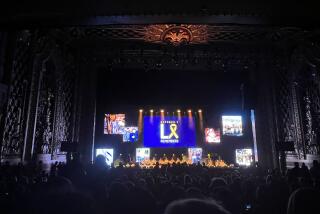A chance to heal at scarred site
WASHINGTON — Two years ago, Tom Heidenberger led a team of amateur cyclists 3,800 miles, from Los Angeles to Washington, to raise money for memorials honoring the victims of the Sept. 11 terrorist attacks.
Biking 180-mile days, through blistering desert heat and thin mountain air, he often considered giving up. At those times, the former airline pilot hunched his body lower over his handlebars and thought about his wife, Michele, a flight attendant with American Airlines.
He thought of the last evening they had spent together -- their daughter’s 20th birthday -- and the way the setting sun had made Michele’s hair glow. He thought about the last words they had said to each other, early the next morning, right before her flight took off from Dulles International Airport near Washington. She had called to remind him to pack their son’s lunch; he said he’d talk to her when she got to L.A.
Within hours, terrorists had commandeered American Airlines Flight 77 and crashed it into the west side of the Pentagon.
Today, President Bush will lead the ceremony dedicating the first national memorial to the victims of that tragic day when four planes were hijacked and nearly 3,000 people were killed. The memorials at the site of the World Trade Center towers in New York and in Shanksville, Pa., where one plane crashed in a field, have been delayed by arguments over construction costs and design.
The two-acre memorial at the Pentagon -- with 184 steel-and-granite benches, each engraved with a victim’s name -- is about 200 feet from the crash site, oriented along the plane’s flight path.
For Heidenberger, 62, the project’s completion is a complicated moment.
“Do I consider this a conclusion? No, not at all,” he said. “I was there yesterday, and what gave me the greatest satisfaction was watching three or four kids sitting on a bench, and it could have been their grandparent or a relative, but they had an opportunity to remember. In a very happy sense, you remember.”
In the week preceding today’s dedication, that is exactly what the victims’ friends and family members did.
Seven years ago, Michael Petrovich was an Army specialist based at the Pentagon. Now a chef in Toronto, he brought his wife to visit the memorial Tuesday.
“That was our boss,” he told his wife, pointing to a small smiling face on a board of photographs just outside the memorial area. Pointing to another picture, he said: “He was a really nice guy.”
The benches, which appear to float above illuminated reflecting pools, are positioned along age lines from the youngest victim, who was 3 years old, to the oldest, who was 71, with the names engraved on one end. Visitors facing the building will read the names of the 125 civilian and military employees who died at the Pentagon. To see the names of the 59 passengers and crew members on the plane, visitors face the other way, toward the open sky.
The first bench Petrovich approached bore the name of Craig Amundson. The two had car-pooled to work together and sat across the room from each other. On Sept. 11, 2001, they had driven to work as usual, then watched on TV as two of the hijacked jets were flown into the World Trade Center towers.
“I turned to Craig and said, ‘Well, we better go call home; we’re going to be working late tonight,’ ” Petrovich said. “So we went back to our desks to make a couple of phone calls, and I had just gotten off the phone when the room shook, the air rippled and a fireball shot over my head.”
Petrovich, who suffered second-degree burns on his face and hands, was able to locate survivors and help lead them to safety through a second-floor window.
On Tuesday, he hesitated in front of the bench honoring his friend. “At first I didn’t want to walk on the gravel or sit on the benches,” he said.
Then he overcame his emotions. “I sat there and told my wife the stories of when we used to go to work together and about his family and children,” he said.
Two months after the attack, family members of the victims formed a committee to work with the Army Corps of Engineers on the memorial project. Despite security concerns, the family members insisted that the site be as close as possible to where their loved ones had died.
Unlike Pentagon tours, which can only be booked by groups through reservations made at least two weeks in advance, the memorial will be open to the public 24 hours a day, seven days a week, starting at 7 tonight.
William R. Stout, deputy chief of operations for the Pentagon Police Department, acknowledged that, from a security standpoint, the location was not ideal. “It would have been nice to have it somewhere else, but it is only logical that it is there,” he said. “We are going to have our eyes on it. We are going to make sure it is secure.”
--
More to Read
Sign up for Essential California
The most important California stories and recommendations in your inbox every morning.
You may occasionally receive promotional content from the Los Angeles Times.










